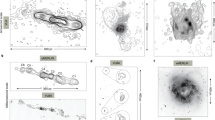Abstract
THE radio source W49 has become of increasing interest recently because of its association with regions of strong anomalous OH emission at radio wavelengths1–6. The source is situated in the galactic plane in a direction of high optical obscuration so that information has to be obtained entirely at radio wavelengths. Observations on the continuum have shown the source to be an HII region and in addition spectral line observations at 21 cm wavelength7 and at the 109α hydrogen recombination line at 6 cm (ref. 8) have indicated that the distance is about 14 kiloparsec. A measure of the electron temperature and of the velocity distribution of the ionized gas has also been obtained from the recombination line observations. This communication presents some new high resolution observations obtained with the recently completed 150 ft radio telescope of the Algonquin Radio Observatory at a wavelength of 2.85 cm, supplemented by observations at 9.45 cm. These results when considered in conjunction with laboratory measurements suggest that the anomalous OH emission observed from the source might be explained as the result of the formation of OH in an electronically excited state by a two-body process.
This is a preview of subscription content, access via your institution
Access options
Subscribe to this journal
Receive 51 print issues and online access
$199.00 per year
only $3.90 per issue
Buy this article
- Purchase on Springer Link
- Instant access to full article PDF
Prices may be subject to local taxes which are calculated during checkout
Similar content being viewed by others
References
Weaver, H., Williams, D. R. W., Dieter, N. H., and Lum, W. T., Nature, 208, 29 (1965).
Weinreb, S., Meeks, M. L., Carter, J. C., Barrett, A. H., and Rogers, A. E. E., Nature, 208, 440 (1965).
Zuckerman, B., Lilley, A. E., and Penfield, H., Nature, 208, 441 (1965).
Dieter, N. H., Weaver, H., and Williams, D. R. W., Sky and Telescope, 31, 132 (1966).
Davies, R. D., de Jager, G., and Verschuur, G. L., Nature, 209, 974 (1966).
Cudaback, D. D., Read, R. B., and Rougoor, G. W., Phys. Rev. Lett., 17, 452 (1966).
Sato, F., Akabane, K., and Kerr, F. J., Austral. J. Phys., 20, 197 (1967).
Mezger, P. G., and Höglund, B., Ap. J., 147, 490 (1967).
Mezger, P. G., and Henderson, A. P., Ap. J., 147, 471 (1967).
Rogers, A. E. E., Moran, J. M., Crowther, P. P., Burke, B. K., Meeks, M. L., Ball, J. A., and Hyde, G. M., Ap. J., 147, 369 (1967).
Spindler, G., Ticktin, S., and Schiff, H. I., Nature, 214, 1006 (1967).
Author information
Authors and Affiliations
Rights and permissions
About this article
Cite this article
HUGHES, V., BUTLER, R. Radio Source W49 and Anomalous OH Emission. Nature 215, 941–942 (1967). https://doi.org/10.1038/215941a0
Received:
Revised:
Issue Date:
DOI: https://doi.org/10.1038/215941a0
This article is cited by
-
The thermal and non-thermal components of sixteen nebular complexes
Astrophysics and Space Science (1977)
Comments
By submitting a comment you agree to abide by our Terms and Community Guidelines. If you find something abusive or that does not comply with our terms or guidelines please flag it as inappropriate.



